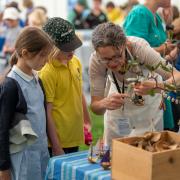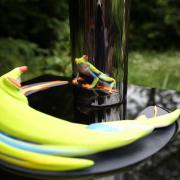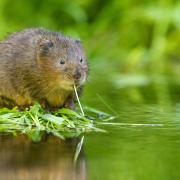Cast your mind back to a time several thousand years ago, when Britain was a more natural place. The ice had receded and woodland coverage was at its peak. It was a time when humans hadn’t created too much havoc. Nature, and people, had space to breathe, in an epoch of environmental harmony.
This was when our native pine marten, present since the last Ice Age, was at its peak – there were an estimated 150,000 of them at a time when humans totalled around 2,500. They were our second most common carnivore after weasels.
But time and the environment changed. The human population grew and woodlands, on which arboreal pine martens depend, decreased. As humans spread so attitudes changed, and by the Middle Ages, after a spell of poor harvests, any creature not regarded as ‘useful’ to people was considered ripe for eradication.
In Tudor times ‘vermin laws’ were introduced, which were only repealed in the late 19th century. Initially these laws targeted the crow family, but later expanded to encompass animals such as pine martens. Many parishes paid bounties to those who killed them, and pine martens, already struggling with habitat loss, were further persecuted for their fur and by shooting estates which regarded them as a threat to the birds they wanted to kill themselves.

Despite all this, the endearing pine marten did manage to hang on in Scotland, with a few pockets in other parts of the UK – even retaining a toehold in the South West where our patchwork landscape of hedges, small fields and pockets of woodland just about provided what they needed.
But their long-term future was bleak and the last recorded sighting of a pine marten in Devon was around 1880, although there have been infrequent later sightings – probably escapees from private collections or fur farms. For almost 150 years our countryside has been devoid of one of its native, middle-sized predators – and we caused their demise.
READ MORE: What is a mustelid and where are they found in the UK?
After the First World War, a gradual, natural regeneration of the pine marten population began to occur in the woodlands of Scotland and England’s northern border counties, and this crucial missing element of a flourishing ecosystem began to re-establish. But any surviving populations in England and Wales were too small to recover without assistance.
Enter the Two Moors Pine Marten Project, a collaboration between Devon Wildlife Trust (DWT), Dartmoor and Exmoor National Park Authorities, the Woodland Trust and the National Trust. The project’s goal is to explore the feasibility of a reintroduction and, if it goes ahead, to restore healthy populations of pine martens to the South West.

Ed Parr Ferris is the conservation manager at DWT responsible for the project.
‘Although pine martens are native,’ he says, ‘we couldn’t just release them without considering their impact. It has to be done responsibly and by consultation with experts, local communities and other interested parties. Bringing them back will bring different challenges for different people, and we need to address any concerns. If all goes well, we hope to start reintroduction from autumn 2024, translocating some from the Scottish population to northern Exmoor and eastern Dartmoor.’
There have already been successful and well-monitored reintroductions in Wales and the Forest of Dean, and the project is working closely with those involved in these earlier initiatives, the results of which have shown that ‘new’ pine martens have behaved and expanded as predicted.
Ed describes the ecology of pine martens. ‘They are mustelids,’ he explains, ‘which means they are in the same family as stoats, weasels and otters, and are the size of a small cat. They are reliant on woodland for exploring and feeding and make dens in old trees. They feed primarily on voles and small mammals, but their diet changes seasonally, and they’ll eat berries in autumn, and insects, birds and eggs in summer. They’ll scavenge carrion in winter, when other food is less available. Pine martens themselves are preyed upon by foxes and large birds of prey.

‘They climb trees, and, although they’re dependent on woodland, can occupy other habitats, such as scrub, hedgerows and craggy areas. They are crepuscular, active at dawn and dusk, and are mostly solitary, mating in July or August with one to three kits being born the following spring.’
Ed says that pine martens are slow to breed, not starting until they are more than two years old, which also limits their ability to expand their range. Their life expectancy is about 12 years.
‘They are critically endangered in England and Wales, so are protected by law,’ he continues. ‘They have an important role in woodlands, being an omnivorous middle-sized predator. Their predation on grey squirrels, and on birds like crows and magpies assists in rebalancing woodlands, helping songbirds thrive and woodlands regenerate.’
Many landowners feel that non-native grey squirrels are detrimental to young trees and Ed expands on this issue (see panel), explaining that pine martens are often regarded as one way of tackling grey squirrels, although they would only play a partial role in this.

Inevitably, when changes are afoot, people have concerns. A big part of the project’s remit is to help allay worries. They first thing to say is that they pose no risk to children!
A reintroduction of pine martens does not mean we’ll have a massive population as this is governed by available habitat. Even in their most ideal environment, the average population density is around one marten in two square kilometres. They have a five to 10 square kilometre ‘home range’, so individuals may overlap, but in the West Country, with our variable-quality habitat, this level is unlikely to be reached.
Very importantly, the project is carefully assessing the impact of pine martens on their prey species. Much of a pine marten’s diet is made up of small mammals and berries, and, opportunistically, they will eat birds including magpies and woodpigeons – but they won’t waste energy hunting them.
The impact on nest-box schemes, for species such as dormice, bats and woodland birds, would need to be assessed and mitigation put in place to stop potential pine marten predation of these. The project is working closely with those who have already carried out successful reintroductions and states: ‘We will be working with the groups that manage nest-box schemes, figuring out how we can mitigate potential problems over a large number of sites.’

They will also be assessing socio-economic risks, consulting with, for instance, poultry farmers and the shooting fraternity who may be concerned about pine marten impact on their activities.
So, having spoken to Ed and seen how the project is progressing, how do I feel about the return of the pine marten?
We must remember that pine martens have co-existed with many bird and other species across their European range for thousands of years. They are a common part of many continental woodlands, along with their close cousin, the wood marten. Their reappearance in our woodlands could help to rebalance habitats, restoring biodiversity to those ecosystems.
In the modern-day we have a more enlightened and educated attitude towards our planet. We understand humanity’s dependence on a healthy natural world and the crucial importance of an environment that is fit for all life to survive in. Reintroduction of a lost native could be a small step in the right direction.
devonwildlifetrust.org



























